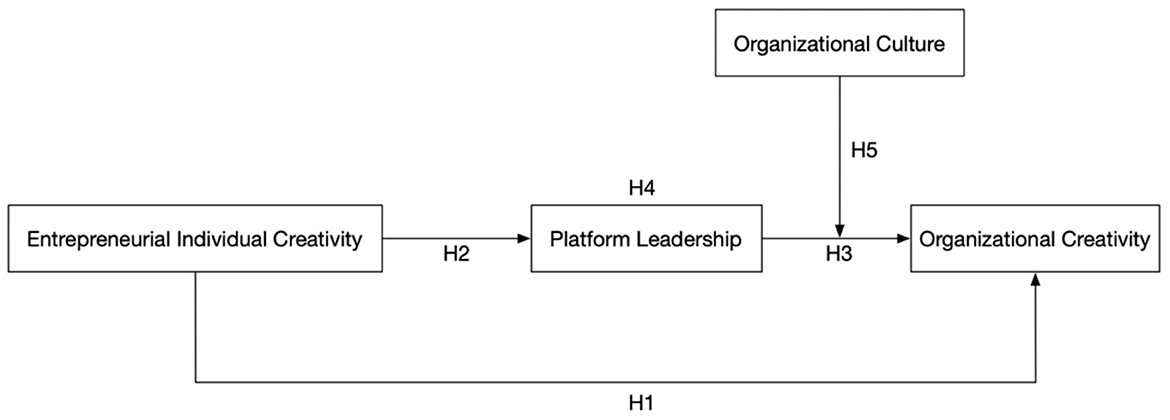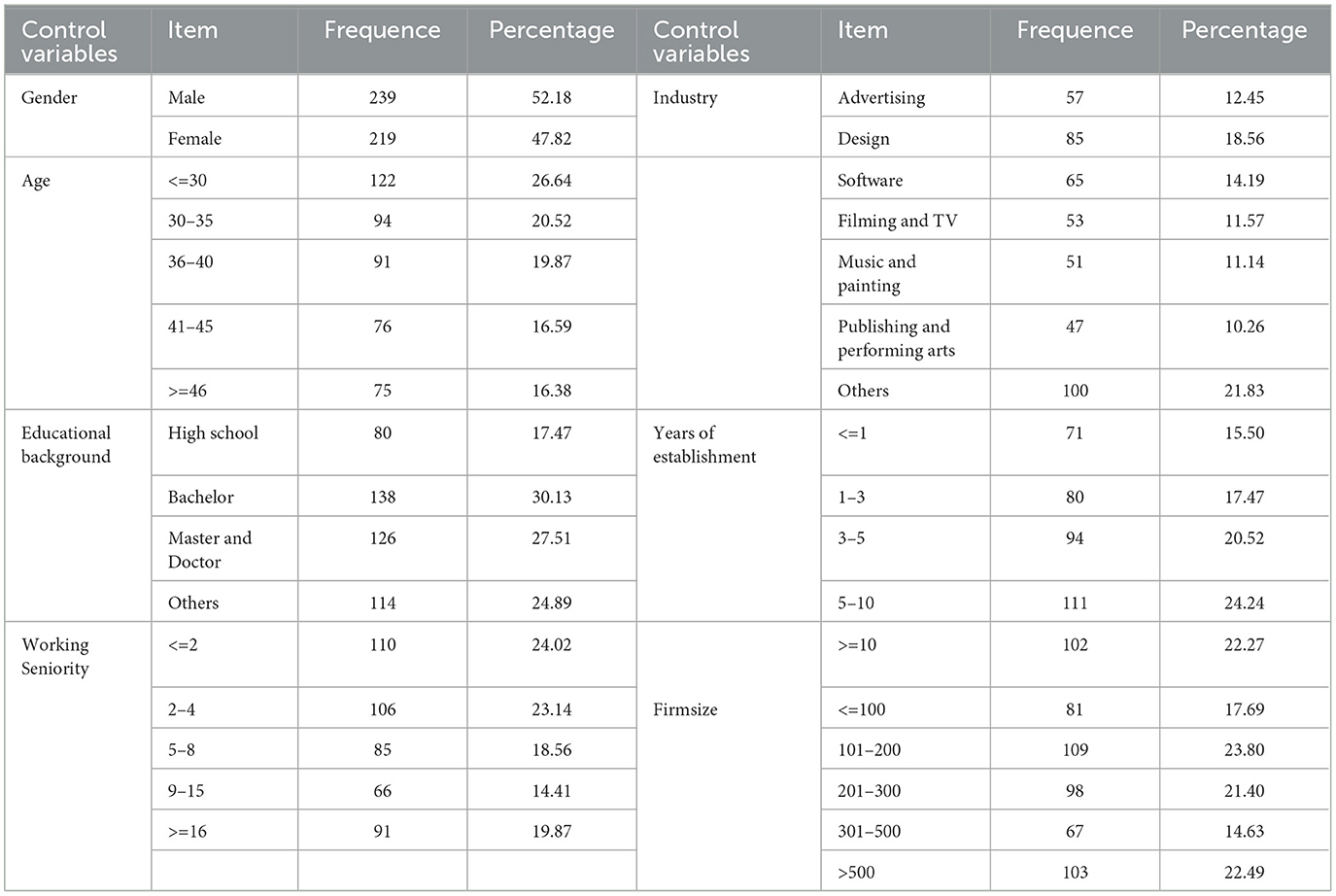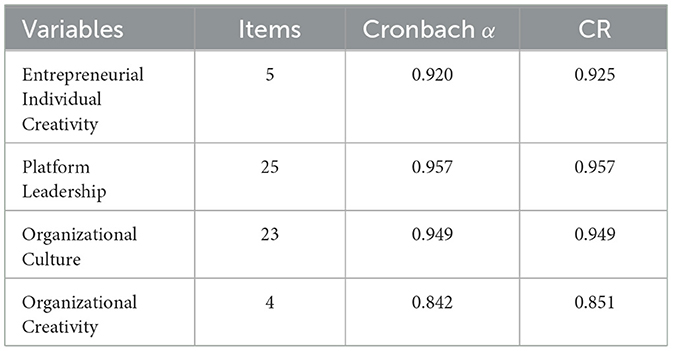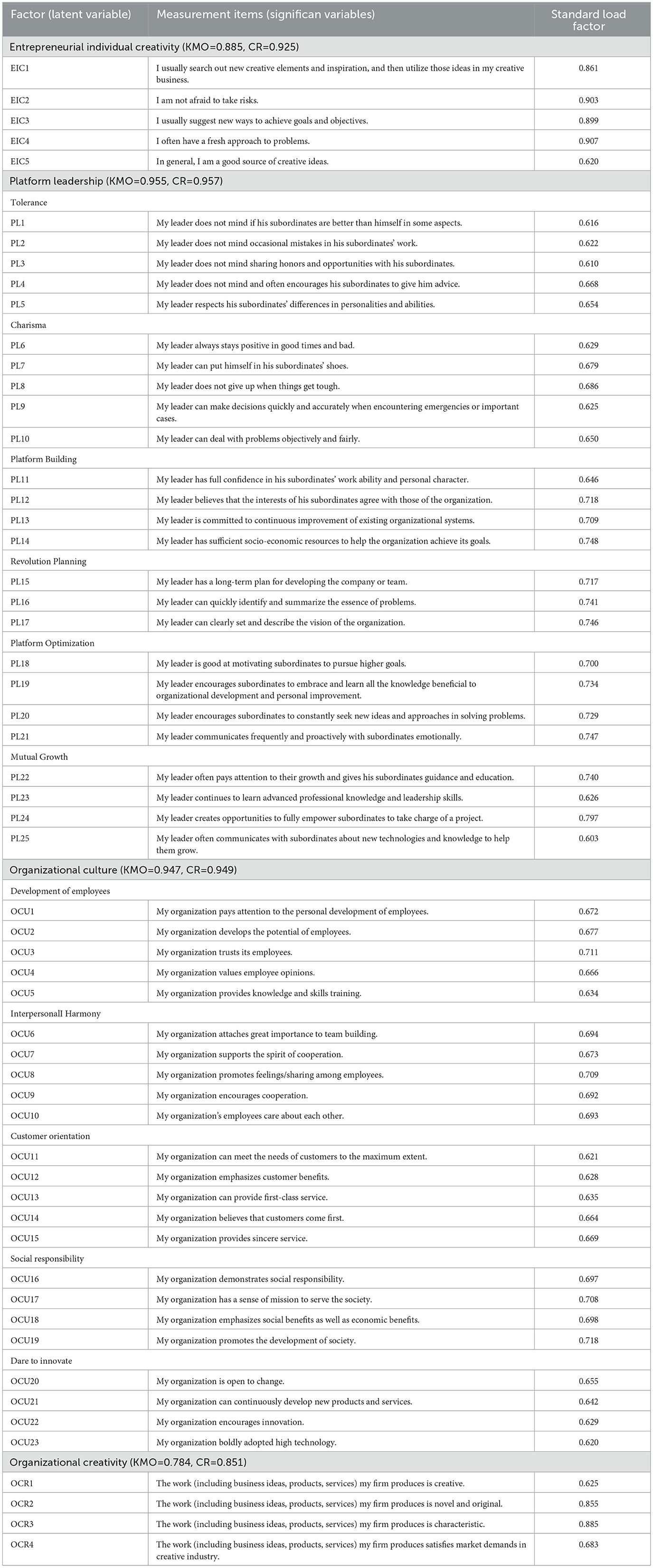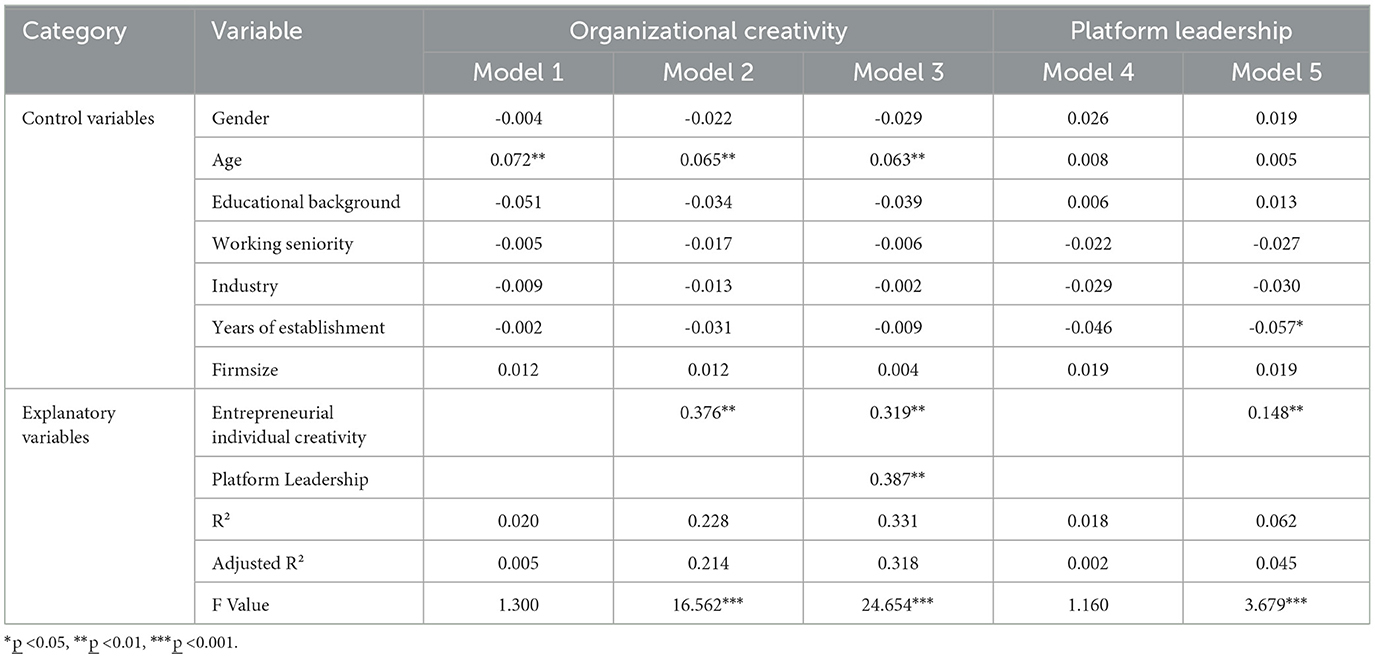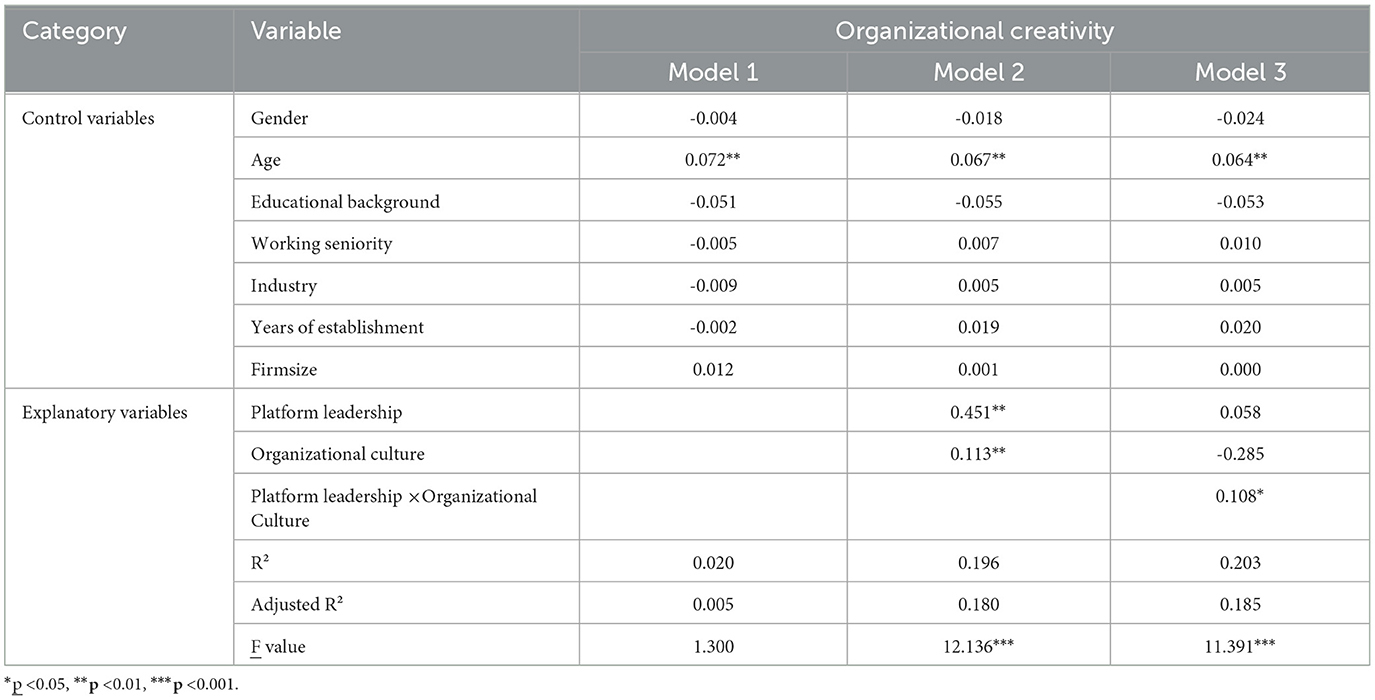- 1Accounting and Auditing College, Guangxi University of Finance and Economics, Nanning, China
- 2Business School, Shandong Normal University, Jinan, China
- 3Management Science Department, City University of Hong Kong, Hong Kong, Hong Kong SAR, China
- 4Management School, Hainan University, Haikou, China
- 5International Business School, Hainan University, Haikou, China
With the intensification of competition in the business environment, organizational creativity is increasingly becoming crucial for organizations to build competitive advantages and promote organizational development. For innovative enterprises, their entrepreneurs largely determine the development orientation of the enterprise. They are one of the most critical factors determining the level of corporate innovation, but there need to be more effective creativity transformation path to pursue innovation development. The findings in this study show that entrepreneurial individual creativity has a significant positive effect on organizational creativity, platform leadership mediates the path of creativity transformation across hierarchical levels, and organizational culture has positive moderating effect between platform leadership and organizational creativity. The study results explain the transformation mechanism of creativity from the entrepreneur's perspective, expand the potential transformation path of organizational creativity, and are instructive for enhancing organizational creativity.
1 Introduction
In an innovation-driven society, creativity is increasingly becoming the critical element in driving organizational development (Makri and Scandura, 2010; Woods et al., 2018). More and more organizations seek to create unique competitive advantages through innovation to survive and thrive in the competitive business environment (Parjanen, 2012; Blomberg et al., 2017). Most innovative companies are still in the early stage of development and need more significant certainty and clarity. The level of organizational creativity largely determines the development prospects of innovative companies (Chang and Chen, 2020). Entrepreneurial individual creativity is the source of innovation, and organizational creativity is the key to maintaining innovation drive and competitive advantage, which together determine the level of innovation of the firm (Pirola-Merlo and Mann, 2004; Yeh-Yun Lin and Liu, 2012). Therefore, it is important to explore the transformation path from entrepreneurial individual creativity to organizational creativity to develop innovative industries (Chang and Chen, 2020).
However, there are still three areas for improvement in the current research on organizational creativity. First, existing research is more concerned with the transformation path of creativity from employees to the organization, but recruiting only creative employees does not meet the organization's need in terms of innovation (Blomberg et al., 2017). And entrepreneurs are employees with special status and positions, with far more power and influence than ordinary employees (Hughes et al., 2018). Still, only some have explored the extent to which the individual creativity traits of entrepreneurs affect the level of innovation in the company, which is not conducive to the further improvement of the level of organizational creativity (Moultrie and Young, 2009; Gao et al., 2020). Second, scholars have explored the mechanisms of their effects on creativity in terms of leadership types, such as Lutz Allen et al. (2013) and Herrmann and Felfe (2014), who explored the relationship between transformational as well as aissez-faire leadership and organizational creativity (Lutz Allen et al., 2013; Herrmann and Felfe, 2014). However, platform leadership still lacks an effective transformation path in the process of transformation from individual creativity to organizational creativity. There needs to be research to confirm whether platform leadership can carry the transformation between the two, and this research situation is not conducive to further expanding the potential paths and transformation mechanisms of creativity from the perspective of leadership types. Finally, organizational culture is usually studied as a driver of organizational creativity. Still, existing studies paid less attention to whether organizational culture interacts with other drivers in the transformation path of creativity, and the role of organizational culture in the path from leadership type to organizational creativity still needs to be further studied (Chitsazan et al., 2017).
To address the research gaps mentioned above, the main tasks of this study are as follows: First, due to the special status and influence of entrepreneurs, this paper explored the mechanism of their roles in the transformation path of organizational creativity from the perspective of entrepreneurial individual creativity, and confirmed that they are the direct drivers of organizational creativity and can motivate entrepreneurs to adopt a platform leadership thus further contributing to the enhancement of organizational creativity. Secondly, platform leadership emphasizes equality and shared relationships among members of the organization, which is conducive to employees following the leader to achieve the company's objective and enhance the organization's creativity. Moreover, because of its role as a link between the upper and lower levels of the organization, platform leadership can take over the transformation of entrepreneurial individual creativity to organizational creativity, i.e., platform leadership plays a mediating role in the transformation path of creativity. Finally, this paper reveals the mechanism between platform leadership, organizational culture and organizational creativity, and explores the moderating role of organizational culture. In transforming from platform leadership to organizational creativity, organizational culture plays a positive moderating role, leading to the further improvement of organizational creativity. The theoretical foundations of this study include Social Cognitive Theory and Social Information Processing Theory. Social Cognitive Theory emphasizes that behavior can shape the environment and that individuals can adjust their attitudes and behaviors based on signals released in the environment. Namely, individuals are not only the shaper of organizational environment, but also the product of organizational environment at the same time (Schunk and DiBenedetto, 2020). And Social Information Processing Theory highlights how individuals adjust themselves to be congruent with the environment based on the information they gather from it. The prerequisite of Social Information Processing Theory is that individual would adjust their behavior and attitude based on social environment, which means we can predict and manage the behavior of organizational member based on organizational environment (Meyer, 1994).
This study aims to explore the pathways of creativity transformation through a survey conducted among members of innovative Chinese enterprises. By investigating this specific organizational context, the research seeks to gain valuable insights into the process of converting creativity into innovation. This study established and improved a cross-level transformation model of organizational creativity from an entrepreneurial perspective, explored entrepreneurial individual creativity as an antecedent factor, and confirmed the positive moderating role of organizational culture in the transformation path of platform leadership and organizational culture. Through the questionnaire survey administered to organizational members and entrepreneur, this study aims to examine the factors and mechanisms that facilitate or hinder the transformation of creative ideas into tangible outcomes within Chinese companies. By identifying the unique pathways and challenges in this context, this research can contribute to a better understanding of the dynamics of creativity transformation and inform strategies to promote innovation in Chinese enterprises.
2 Research framework and hypothesis
According to existing researches, the level of organizational creativity depends on entrepreneurial individual creativity, platform leadership, and organizational culture (Andleeb et al., 2019; Schunk and DiBenedetto, 2020; Yang et al., 2022). Based on Social Cognitive Theory and Social Information Processing Theory, this paper established a cross-level creativity transformation model from entrepreneurs to organizations, this study's theoretical model and hypotheses are shown in Figure 1.
Creativity is a kind of intangible asset without specific measurements, which is the source of organizational innovation and the key to winning in competition (Baron and Tang, 2011; Andleeb et al., 2019). For innovative firms, it is even more important to rely on creativity to attract potential customers, (Ramos et al., 2022) and thus increase the market share of the firm to win in the business competition (Pagano et al., 2018). Entrepreneurial individual creativity refers to the ability of entrepreneurs to produce new ideas of practical significance through appropriate information and knowledge (Zampetakis and Moustakis, 2006). According to the Social Cognitive Theory, individuals will pursue innovative entrepreneurial goals if they believe their creativity can achieve the desired results (Schunk and DiBenedetto, 2020). According to the Social Information Processing Theory, entrepreneurs, as leaders of innovative enterprises, are important sources of information in the organization, able to provide a variety of information and resources to organizational members, and able to influence the attitudes and behaviors of organizational members (Meyer, 1994). As entrepreneurs are different from ordinary employees in terms of influence and power, their creativity largely affects the overall level of creativity of the organization, the higher the individual creativity of entrepreneurs, the higher the organizational creativity and innovation potential that they can unleash (Yeh-Yun Lin and Liu, 2012; Xu and Zhao, 2020). Therefore, this paper proposes the following hypotheses:
H1: Entrepreneurial individual creativity is positively correlated with organizational creativity.
Platform leadership is grounded on the construction of digital information platform, highlighting the importance of entrepreneurs dynamically stimulating the inherent qualities of their employees through their inclusive attributes and personal charisma in a top-down fashion (Yang et al., 2022). Platform leadershipaims to foster change-oriented behaviors, ultimately leading to the collective development of employees, entrepreneurs, and the organization (Yang et al., 2022). According to Social Information Processing Theory, entrepreneurs are important sources of information in organizational contexts and can provide various information resources within the organization (Xu and Zhao, 2020). Since the risks faced in the process of innovation and entrepreneurship are unknown, the material resources, information resources , and organizational support provided by the organization can help organizational members to reduce their fear and aversion to risk (Catalano et al., 2018). To allow organizational members to give full play to their creativity, and to form the organizational atmosphere of proactive change within the organization, entrepreneurs tend to send signals of innovation to organizational members utilizing the digital information platform. These platforms have powerful data integration capabilities, which can positively influence the performance of creativity within the organization (Benitez et al., 2022). By leveraging these platforms, entrepreneurs can send signals of innovation to organizational members, encouraging them to embrace and contribute to a culture of creativity and change, which will help them to form a benign atmosphere of innovation (Yang et al., 2022). Therefore, this paper proposes the hypothesis:
H2: Entrepreneurial individual creativity is positively correlated with platform leadership.
Organizational creativity refers to the innovative perspectives implemented to achieve the enhancement of production, processes, and services, which can improve organizational performance and increase the core competitiveness of the enterprise to achieve substantial development of the enterprise (OUARI and Lefkir, 2022). Existing studies have shown that, at the organizational level, leadership type is an important factor influencing organizational innovation behavior (Khedhaouria et al., 2015). While the platform leadership emphasizes the equal and shared relationship between organizational members, it can adopt a bottom-top approach to lead employees, respond to changes in the external environment of the organization, and ultimately promote the achievement of organizational goals (Morris et al., 2005). Organizations adopting platform leadership can establish an information platform that integrates resources from all parties, shapes the organizational learning atmosphere, and thus motivates organizational members to share information, which is conducive to the implementation of innovation at the organizational level (Yang et al., 2022). Therefore, this paper proposes the hypothesis:
H3: Platform leadership is positively correlated with organizational creativity.
Entrepreneurial individual creativity is the ability of entrepreneurs to find new opportunities, or to transform ideas into actual organizational outputs (Fillis and Rentschler, 2010). At present, there is a lack of effective transformation mechanism between entrepreneurial individual creativity and organizational creativity, so this paper introduces platform leadership to explore its role in the transformation path from entrepreneurial creativity to organizational creativity. With the development of information network technology, the external environment faced by innovation-oriented enterprises has become more unpredictable, and to seek survival and development in this environment, entrepreneurs expect organizations to show a trend of decentralization and de-leadership (Vaara et al., 2021). Platform leadership focuses on building a digital information platform within the organization, which is characterized by inclusiveness, personal charisma, platform building, change planning, platform optimization, and common growth, and can achieve the mutual development of employees, entrepreneur, and organization, as well as integrating more high-quality resources to enhance the level of creativity of the entire organization (Yang et al., 2022). According to the Social Exchange Theory, the two parties who establish a social exchange relationship follow the principle of reciprocity. If the organization can give enough authorization, resources, and platform to its members, in exchange, the employees will also enhance their sense of responsibility and belonging to the organization, which will stimulate the initiative of the organization members to innovate, and further enhance the organization's overall level of creativity (Fuller et al., 2006). Platform leadership emphasizes support, tolerance, and understanding of organizational members, and when organizational members feel organizational support, it can reduce their negative emotions such as fear and dissatisfaction about the risks involved in innovation work (Eisenberger et al., 2020). According to the Social Information Processing Theory, within an organization, information affects the behavior of organizational members by influencing individual perceptions (Meyer, 1994). Therefore, platform leadership can enhance the power of entrepreneurial individual creativity , which is conducive to the development of innovation within the organization, and the further enhancement of the organization's overall level of creativity. Therefore, this paper proposes the hypothesis:
H4: Platform leadership mediates between entrepreneurial individual creativity and organizational creativity.
Organizational culture is a kind of umbrella term for beliefs about shared values that can shape behavioral norms within an organization and create an organizational way of life (Al Shehri et al., 2017). Organizational culture can play a supportive, interactive, sharing role within the organization, which can motivate organizational members to think creatively and be oriented to work creatively, a strong organizational culture is the key to motivating organizational members to think and act creatively (Andleeb et al., 2019). If the organization expects to be able to form an the innovative atmosphere within the organization, it is necessary to make its organizational culture sufficiently flexible to provide the organization members with the opportunity to think and behave creatively. If the organization expects to form an innovative atmosphere within the organization, it is necessary to make its organizational culture flexible enough to provide a comfortable and flexible working environment and atmosphere for the members, to enhance their sense of responsibility and sense of belonging to the organization (De Clercq and Mustafa, 2023), which is conducive to the development of innovative work within the organization, and thus enhance the level of organizational creativity for the whole (Jeong et al., 2017). According to Bandura's Reciprocal Determinism, organizational culture is one of the key factors driving the innovative and entrepreneurial behaviors of organizational members (Zhao et al., 2020). Under the influence of the robust organizational culture, entities that embrace platform leadership can exhibit heightened inclusiveness in navigating the challenges associated with innovation and entrepreneurship (De Clercq and Mustafa, 2023). This fosters an environment conducive to alleviating employees' feelings of insecurity and fear associated with the risks posed by innovation. Guided by platform leadership, the organization becomes more dedicated to the strategic planning and execution of innovative initiatives, thereby bolstering the overall level of organizational creativity (Carmeli et al., 2014). Therefore, this paper proposes the hypothesis:
H5: Organizational culture positively regulates the relationship between platform leadership and organizational creativity.
3 Materials and methods
3.1 Data collection
In the competitive business environment, creativity is the key for enterprises, especially innovative enterprises, aiming to build core competitiveness and realize their survival and development. Therefore, in this paper, entrepreneurs and organization members of innovative enterprises were selected as survey respondents, encompassing different developing levels of enterprises located in representative cities in the north, middle, and southeast of China. And online questionnaires were generated using the Questionnaire Star platform, corresponding links and QR codes of the questionnaires were sent through social platforms, such as WeChat and QQ, to invite the respondents to access the questionnaires. The questionnaire collection lasted ten months from January 2023 to November 2023, and 458 valid samples were obtained. The descriptive statistics of the samples are shown in Table 1.
3.2 Variable measurement
In order to guarantee the reliability and validity of the measurement scales, the items of the mature measurement scales were selected for this study and refined with the context and characteristics of the study. The scales in this paper are all scored on Likert 5-point scale, with 1–5 indicating from fully inconsistent to fully consistent.
1. Entrepreneurial individual creativity.
According to Gao et al. (2021), entrepreneurial individual creativity contains five items (Gao et al., 2021).
2. Platform leadership.
Drawing on the scale of Yang et al. (2022) and other scholars, platform leadership is measured in six dimensions: tolerance, charisma, platform building, revolution planning, platform optimization, and mutual growth (Yang et al., 2022). In total, this measure contains 25 items..
3. Organizational creativity.
Drawing on the scale of Gao et al. (2021) to measure organizational creativity, the measure contains a total of five items (Gao et al., 2021).
4. Organizational culture.
Based on Anne Kennan et al. (2006), this study measured organizational culture in five dimensions, development of employees, interpersonal harmony, customer orientation, social responsibility, and dare to innovate (Anne Kennan et al., 2006; Tsui et al., 2006). Organizational culture contains a total of 23 items.
3.3 Reliability and validity tests
Descriptive statistics and correlation coefficients are shown in Table 2. The results show that there is a positive correlation between entrepreneurial individual creativity and platform leadership (cor = 0.195, p <0.01), a positive correlation between entrepreneurial individual creativity and organizational creativity (cor = 0.228, p <0.01), and a positive correlation between platform leadership and organizational creativity (cor = 0.302, p <0.01), and that the above results initially validate the hypotheses H1, H2, and H3.
According to Table 3, the Cronbach's α values for the four variables were >0.9, making them suitable for further confirmatory factor analysis.
As shown in Table 4, the confirmatory factor analysis was conducted using SPSS 27.0 for scales of this study and the validity test was performed directly. The results showed that the standardized load factors were all within the acceptable range (>0.600), which indicates that there is a strong correlation between the latent variables and the analytic item measures. The value of CR>0.900, indicating high convergent validity, and KMO>0.70, which indicates that the validity of the study data is feasible.
4 Empirical testing and analysis
4.1 Research method selection
The purpose of this study is to explore the cross-level transformation path and mechanism from entrepreneurial individual creativity to organizational creativity. According to the existing research, this paper explores the transformation of organizational creativity from entrepreneurial individual creativity, platform leadership and organizational culture. This paper adopts multilevel regression analysis to analyze the correlation between variables, the core of multilevel regression analysis is still regression analysis, but it can be divided into multiple layers, which is conducive to exploring whether the newly put variables have explanatory strength for the model. In this paper, the PROCESS tool is used to test the mediating effect and moderating effect, and the Bootstrap method is adopted to sample the mediating effect, and an estimated confidence interval is constructed by sampling with put-back, which is a more efficient method and has no restriction on the distribution of mediating samples.
4.2 Correlation test
In this paper, hypotheses were tested using multilevel regression using SPSS 27.0 software. As shown in Table 5, the multilevel regression analysis for organizational creativity involves a total of three models. The explained variable of the model is organizational creativity, and the independent variables of model 1 are control variables (gender, age, educational background, working seniority, industry, years of establishment, and firmsize), and model 1 examines the effects of the control variables. Model 2 adds entrepreneurial individual creativity on the basis of model 1, and the results show that there is a significant positive correlation between entrepreneurial individual creativity and organizational creativity (β = 0.376, p < 0.001), and H1 is proved. Model 3 adds platform leadership on the basis of model 2, and the results show that there is a significant positive correlation between platform leadership and organizational creativity (β=0.387, p < 0.001), and H3 is proved.
As shown in Table 5, the multilevel regression analysis for platform leadership involves two models. Among them, the independent variables in Model 4 are control variables (gender, age, educational background, working seniority, industry, years of establishment, firmsize), and Model 5 adds entrepreneurial individual creativity on the basis of Model 4. The explained variable of this model is platform leadership, and the results show that there is a significant positive correlation between entrepreneurial individual creativity and platform leadership (β= 0.148, p < 0.01), and H2 is proved.
4.3 Mediation effect test
This paper was validated using the PROCESS tool in SPSS 27.0. The results are shown in Table 6, under the measurement of Bootstrap method with 5,000 times of repeated sampling, the coefficient of entrepreneurial individual creativity to platform leadership is 0.1374, and the coefficient of platform leadership to organizational creativity is 0.3895 in 95% confidence range, after calculating 0.1379*0.3892 ≈ 0.0537, which is consistent with the results of the analysis results, and together with the confidence interval (LLCI=0.0256, ULCI=0.0846) does not contain 0, which means that it is proved that platform leadership can act as a mediating variable and play a significant mediating effect between entrepreneurial individual creativity and organizational creativity, and H4 is confirmed.
4.4 Moderation effect test
In this paper, the multilevel regression in SPSS 27.0 was used to conduct the effect test with moderated mediating utility, and the control variables were tested together, and the results are shown in Table 7, the effect value of the interaction term (platform leadership × organizational culture) is 0.108, and the p-value is 0.047 which is less than 0.05, indicating that organizational culture has a significant effect on the relationship between in platform leadership and organizational creativity is significant.Therefore, organizational culture can play a positive moderating role between platform leadership and organizational creativity, H5 has been proved.
5 Discussion
This study established a cross-level creativity transformation model from entrepreneurs to organizations based on social cognitive theory and social information processing theory. Overall, the cross-level creativity transformation model expands the potential paths of creativity transformation and improves the research on platform leadership and organizational culture in the mechanism of creativity transformation. This study presents a robust predictive ability for organizational creativity, which can well reflect the formation causes and transformation paths of organizational creativity. The research findings of this study are threefold:
First, this paper validated the positive impact of entrepreneurial individual creativity on organizational creativity. Individual creativity is the source of innovation, however, exploring the transformational path of organizational creativity only from the perspective of employees cannot meet the needs of organizational innovation (Blomberg et al., 2017). Existing research suggests that entrepreneurs are superior to ordinary employees in terms of power, status, and influence (Hughes et al., 2018), therefore, entrepreneurial individual creativity is an important driver of organizational creativity, and can positively influence the enhancement of organizational creativity (Yeh-Yun Lin and Liu, 2012; Xu and Zhao, 2020). This paper confirms the cross-level transformation path of creativity from entrepreneurs to organizations through empirical tests, verifies the important role of entrepreneurial individual creativity in the transformation of creativity, indicating its contribution to the further enhancement of organizational creativity.
Second, this study explored the mechanism of leadership type from the perspective of creativity transformation. Existing studies mostly focus on the relationship between leadership type and organizational creativity (Herrmann and Felfe, 2014; Sirkwoo, 2015), but lack research on whether it can undertake the transformation of creativity from individuals to organizations across hierarchical levels (Ozsahin and Sudak, 2015). Drawing on the social information processing theory and the social exchange theory, platform leadership can transfer information and resources across hierarchical levels by building a digital information platform (Yang et al., 2022). Platform leadership owns the nature of equality and sharing, which can establish the innovative working atmosphere within organization, allowing organization members to give full play to their creativity (Benitez et al., 2022). Constructing digital platofrm helps individuals to carry out the innovative and creative work at the organizational level, and enhances the innovative atmosphere of the whole organization (Xu and Zhao, 2020; Yang et al., 2022). On the basis of the above research, this paper confirms that platform leadership can undertake the transformation of creativity between entrepreneurs and organizations, therefore, entrepreneurs with platform leadership, specifically in entrepreneurial enterprise, are able to utilize digital platform to assist the enhancing for the level of organizational creativity.
Finally, this paper explored the interacting role of organizational culture in the path of creativity transformation. Organizational culture is the important motivator of innovative behavior (Zhao et al., 2020). The emotional value provided by organizational culture to organizatinal members can enhance their emotional commitment to organization (Tsui et al., 2006), showing a stronger sense of responsibility and belonging, and driving them to carry out innovative and entrepreneurial behaviors (Jeong et al., 2017). This paper explained the deepening role of organizational culture for platform leadership, explored the transformational path of organizational creativity in the perspective of organizational culture, and confirmed the effectiveness of the path through empirical data. Namely, this study validated the significant positive moderating effect of organizational culture, which is of strong practical significance for enhancing the level of organizational innovation from the level of organizational culture.
In summary, this study expanded the existing research about organizational creativity from several perspectives and confirmed the validation in the context of entrepreneurial enterprise in China. Particularly, a cross-level creativity transformation model was established from entrepreneurs to organizations, confirming the validity of the creativity transformation path from entrepreneurs to organizations. Furthermore, this study supplemented the gaps of the existing creativity research in the platform leadership perspective, expanded the transformation path of organizational creativity, improved the application space of the existing theories to a certain extent, which has practical significance for further enhancement of the level of organizational creativity from the entrepreneurial perspective , specifically in the context of China. From a practical perspective, entrepreneurs can implement a series of measures to enhance the creativity of their organizations. This includes supporting the construction of a digital information platform, promoting the engagement in creative activities, and integrating elements of Chinese traditional culture to create a more syncretic organizational culture aligned with the context of China. The cross-level creativity model developed in this study identifies the transformation path of creativity from entrepreneurs to the organization. This model proves valuable in effectively harnessing the positive impact of platform leadership and organizational culture, enhancing creative activities and thinking. It provides a practical methodology for organizations to establish a creative environment, offering concrete steps for entrepreneurs to foster innovation within their organizations. In future research, it would be beneficial to explore universal transformational approaches that can be applied to enhance organizational creativity, which can be universally applied across different organizational contexts to foster and improve creativity.
Data availability statement
The original contributions presented in the study are included in the article/supplementary material, further inquiries can be directed to the corresponding author.
Ethics statement
Ethical approval was not required for the studies involving humans in accordance with local legal and institutional requirements. The studies were conducted in accordance with the local legislation and institutional requirements. The participants provided their written informed consent to participate in this study.
Author contributions
XY: Funding acquisition, Writing—original draft, Writing—review & editing. MZ: Investigation, Funding acquisition, Writing— original draft. ZM: Investigation, Writing—original draft, Data curation, Methodology, Software, Writing—review & editing. YS: Data curation, Writing—original draft. XD: Writing—review & editing, Methodology, Formal analysis.
Funding
The author(s) declare financial support was received for the research, authorship, and/or publication of this article. This work was supported by Guangxi First-class Discipline statistics Construction Project Fund, Cultivation Program for 1,000 Young and Middle-aged Backbone Teachers in Guangxi Colleges and Universities Humanities and Social Sciences Project (2023QGRW042), Hainan Provincial Natural Science Foundation of China (724QN241, 724RC489), Social Science Planning Project of Shandong Province (No. 22DTQJ03), and Natural Science Foundation of Shandong Province (ZR2020QG017).
Conflict of interest
The authors declare that the research was conducted in the absence of any commercial or financial relationships that could be construed as a potential conflict of interest.
Publisher's note
All claims expressed in this article are solely those of the authors and do not necessarily represent those of their affiliated organizations, or those of the publisher, the editors and the reviewers. Any product that may be evaluated in this article, or claim that may be made by its manufacturer, is not guaranteed or endorsed by the publisher.
References
Al Shehri, M., McLaughlin, P., Al-Ashaab, A., and Hamad, R. (2017). The impact of organizational culture on employee engagement in saudi banks. J. Hum. Resour. Manag. 1, 1–23. doi: 10.5171/2017.761672
Andleeb, N., Chan, S. W., and Nazeer, S. (2019). Triggering employee creativity through knowledge sharing, organizational culture and internal marketing. Int. J. Innov. Technol. Exp.Eng. 8, 2–6.
Anne Kennan, M., Cole, F., Willard, P., Wilson, C., and Marion, L. (2006). “Changing workplace demands: what job ads tell us,” in Aslib Proceedings (Bradford: Emerald Group Publishing Limited), 179–196. doi: 10.1108/00012530610677228
Baron, R. A., and Tang, J. (2011). The role of entrepreneurs in firm-level innovation: Joint effects of positive affect, creativity, and environmental dynamism. J. Busi. Vent. 26, 49–60. doi: 10.1016/j.jbusvent.2009.06.002
Benitez, J., Arenas, A., Castillo, A., and Esteves, J. (2022). Impact of digital leadership capability on innovation performance: the role of platform digitization capability. Inform. Manage. 59, 103590. doi: 10.1016/j.im.2022.103590
Blomberg, A., Kallio, T., and Pohjanpää, H. (2017). Antecedents of organizational creativity: drivers, barriers or both? J. Innovat. Manage. 5, 78–104. doi: 10.24840/2183-0606_005.001_0007
Carmeli, A., Sheaffer, Z., Binyamin, G., Reiter-Palmon, R., and Shimoni, T. (2014). Transformational leadership and creative problem-solving: the mediating role of psychological safety and reflexivity. J. Creat. Behav. 48, 115–135. doi: 10.1002/jocb.43
Catalano, A. S., Redford, K., Margoluis, R., and Knight, A. T. (2018). Black swans, cognition, and the power of learning from failure. Conserv. Biol. 32, 584–596. doi: 10.1111/cobi.13045
Chang, Y.-Y., and Chen, M.-H. (2020). Creative entrepreneurs' creativity, opportunity recognition, and career success: Is resource availability a double-edged sword? Eur. Manag. J. 38, 750–762. doi: 10.1016/j.emj.2020.03.004
Chitsazan, H., Bagheri, A., and Yusefi, A. (2017). Intellectual, psychological, and social capital and business innovation: the moderating effect of organizational culture. Iran. J. Manage. Stud. 10, 307–333. doi: 10.22059/ijms.2017.215054.672249
De Clercq, D., and Mustafa, M. J. (2023). How transformational leaders get employees to take initiative and display creativity: the catalytic role of work overload. Personnel Rev. 53, 488–507. doi: 10.1108/PR-02-2022-0090
Eisenberger, R., Rhoades Shanock, L., and Wen, X. (2020). Perceived organizational support: Why caring about employees counts. Annu. Rev. Organ. Psychol. Organ. Behav. 7, 101–124. doi: 10.1146/annurev-orgpsych-012119-044917
Fillis, I., and Rentschler, R. (2010). The role of creativity in entrepreneurship. J. Enterpr. Culture 18, 49–81. doi: 10.1142/S0218495810000501
Fuller, J. B., Marler, L. E., and Hester, K. (2006). Promoting felt responsibility for constructive change and proactive behavior: Exploring aspects of an elaborated model of work design. J. Organizat. Behav. 27, 1089–1120. doi: 10.1002/job.408
Gao, Y., Zhang, D., Ma, H., and Du, X. (2020). Exploring creative entrepreneurs' ieo: extraversion, neuroticism and creativity. Front. Psychol. 11, 2170. doi: 10.3389/fpsyg.2020.02170
Gao, Y., Zhao, X., Xu, X., and Ma, F. (2021). A study on the cross level transformation from individual creativity to organizational creativity. Technol. Forecast. Soc. Change 171, 120958. doi: 10.1016/j.techfore.2021.120958
Herrmann, D., and Felfe, J. (2014). Effects of leadership style, creativity technique and personal initiative on employee creativity. Br. J. Manage. 25, 209–227. doi: 10.1111/j.1467-8551.2012.00849.x
Hughes, D. J., Lee, A., Tian, A. W., Newman, A., and Legood, A. (2018). Leadership, creativity, and innovation: a critical review and practical recommendations. Leadersh. Q. 29, 549–569. doi: 10.1016/j.leaqua.2018.03.001
Jeong, S., McLean, G. N., McLean, L. D., Yoo, S., and Bartlett, K. (2017). The moderating role of non-controlling supervision and organizational learning culture on employee creativity: the influences of domain expertise and creative personality. Eur. J. Train. Dev. 41, 647–666. doi: 10.1108/EJTD-03-2017-0025
Khedhaouria, A., Gurău, C., and Torrès, O. (2015). Creativity, self-efficacy, and small-firm performance: the mediating role of entrepreneurial orientation. Small Busi. Econ. 44, 485–504. doi: 10.1007/s11187-014-9608-y
Lutz Allen, S., Smith, J. E., and Da Silva, N. (2013). Leadership style in relation to organizational change and organizational creativity: perceptions from nonprofit organizational members. Nonprofit Manage. Leadersh. 24, 23–42. doi: 10.1002/nml.21078
Makri, M., and Scandura, T. A. (2010). Exploring the effects of creative ceo leadership on innovation in high-technology firms. Leadersh. Q. 21, 75–88. doi: 10.1016/j.leaqua.2009.10.006
Meyer, G. W. (1994). Social information processing and social networks: a test of social influence mechanisms. Hum. Relat. 47, 1013–1047. doi: 10.1177/001872679404700901
Morris, J. A., Brotheridge, C. M., and Urbanski, J. C. (2005). Bringing humility to leadership: antecedents and consequences of leader humility. Hum. Relat. 58, 1323–1350. doi: 10.1177/0018726705059929
Moultrie, J., and Young, A. (2009). Exploratory study of organizational creativity in creative organizations. Creat. Innovat. Manage. 18, 299–314. doi: 10.1111/j.1467-8691.2009.00536.x
OUARI, H., and Lefkir, A. (2022). The effect of positive psychological capital dimensions on organizational creativity. Soc. Sci. J. 16, 986–997. doi: 10.34118/ssj.v16i1.1988
Ozsahin, M., and Sudak, M. K. (2015). The mediating role of leadership styles on the organizational citizenship behavior and innovativeness relationship. J. Busi. Econ. Finance 4, 3. doi: 10.17261/Pressacademia.2015313065
Pagano, A., Petrucci, F., and Bocconcelli, R. (2018). A business network perspective on unconventional entrepreneurship: a case from the cultural sector. J. Bus. Res. 92, 455–464. doi: 10.1016/j.jbusres.2018.07.012
Parjanen, S. (2012). Experiencing creativity in the organization: From individual creativity to collective creativity. Interdisc. J. Inform. Knowl. Manage. 7, 109–128. doi: 10.28945/1580
Pirola-Merlo, A., and Mann, L. (2004). The relationship between individual creativity and team creativity: aggregating across people and time. J. Organ. Behav. 25, 235–257. doi: 10.1002/job.240
Ramos, H. M., Mustafa, M., and Badri, S. K. Z. (2022). Job and work context elements in fostering employee creative behavior: exploring the moderating role of work passion. J. Manage. Organizat. 2022, 1–20. doi: 10.1017/jmo.2022.52
Schunk, D. H., and DiBenedetto, M. K. (2020). Motivation and social cognitive theory. Contemp. Educ. Psychol. 60, 101832. doi: 10.1016/j.cedpsych.2019.101832
Sirkwoo, J. (2015). Leading employee creativity: the relationship between leadership styles and employee creativity. Rev. Gen. Manage. 21, 17–28.
Tsui, A. S., Wang, H., and Xin, K. R. (2006). Organizational culture in china: an analysis of culture dimensions and culture types. Manage. Organizat. Rev. 2, 345–376. doi: 10.1111/j.1740-8784.2006.00050.x
Vaara, E., Harju, A., Leppälä, M., and Buffart, M. (2021). How to Successfully Scale a Flat Organization. (Brighton: Harvard Business Review).
Woods, S. A., Mustafa, M. J., Anderson, N., and Sayer, B. (2018). Innovative work behavior and personality traits: examining the moderating effects of organizational tenure. J. Manag. Psychol. 33, 29–42. doi: 10.1108/JMP-01-2017-0016
Xu, W., and Zhao, S. (2020). The influence of entrepreneurs' psychological capital on their deviant innovation behavior. Front. Psychol. 11, 1606. doi: 10.3389/fpsyg.2020.01606
Yang, X., Jin, R., and Zhao, C. (2022). Platform leadership and sustainable competitive advantage: the mediating role of ambidextrous learning. Front. Psychol. 13, 836241. doi: 10.3389/fpsyg.2022.836241
Yeh-Yun Lin, C., and Liu, F.-C. (2012). A cross-level analysis of organizational creativity climate and perceived innovation: the mediating effect of work motivation. Eur. J. Innovat. Managem. 15, 55–76. doi: 10.1108/14601061211192834
Zampetakis, L. A., and Moustakis, V. (2006). Linking creativity with entrepreneurial intentions: a structural approach. Int. Entrepren. Manage. J. 2, 413–428. doi: 10.1007/s11365-006-0006-z
Keywords: entrepreneurial individual creativity, organizational creativity, platform leadership, organizational culture, cross-level transformation of creativity
Citation: Yang X, Zhang M, Meng Z, Shen Y and Du X (2024) Cross-level transformation of creativity from entrepreneurs to organizations. Front. Psychol. 15:1278996. doi: 10.3389/fpsyg.2024.1278996
Received: 18 August 2023; Accepted: 20 February 2024;
Published: 08 March 2024.
Edited by:
Mike James Mustafa, University of Nottingham Malaysia, MalaysiaReviewed by:
Sheng Huang, University of Nottingham Malaysia Campus, MalaysiaSiti Khadijah Zainal Badri, University of Nottingham Malaysia Campus, Malaysia
Copyright © 2024 Yang, Zhang, Meng, Shen and Du. This is an open-access article distributed under the terms of the Creative Commons Attribution License (CC BY). The use, distribution or reproduction in other forums is permitted, provided the original author(s) and the copyright owner(s) are credited and that the original publication in this journal is cited, in accordance with accepted academic practice. No use, distribution or reproduction is permitted which does not comply with these terms.
*Correspondence: Zixuan Meng, eml4dWFtZW5nNC1jQG15LmNpdHl1LmVkdS5oaw==
 Xiu Yang
Xiu Yang Meng Zhang
Meng Zhang Zixuan Meng
Zixuan Meng Yingxian Shen
Yingxian Shen Xiaomin Du
Xiaomin Du